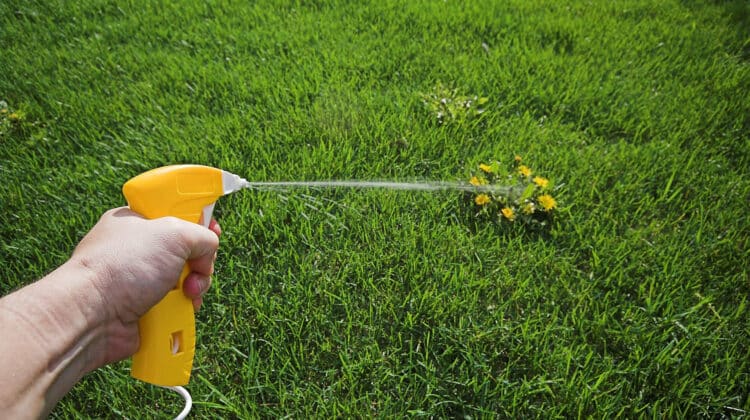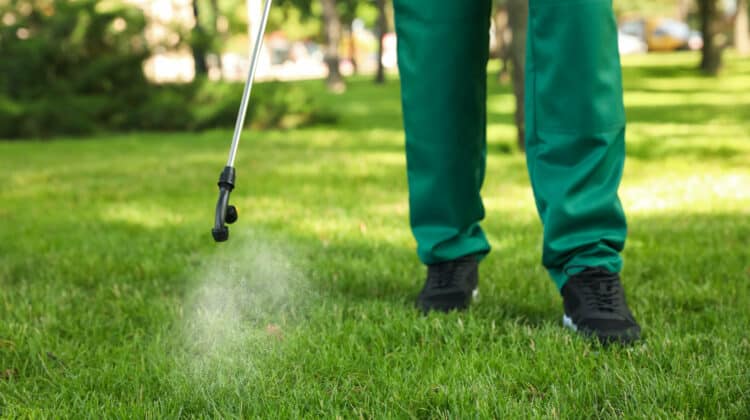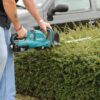
Do you like to know how to make grass thicker and fuller? You might think it’s an easy enough undertaking, wherein it’s just mowing and watering turfgrass. There’s more stuff to do than that, very much more.
There are essential things to consider, like aerating and fertilizing, which are complicated procedures to do.
If you do the right approach, your garden or lawn will be healthy and strong enough to resist weeds, pests, drought, and diseases.
Your ultimate goal is to have a lush and well-manicured lawn that will be the envy in your whole neighborhood. An ideal spot where you can relax with your family and friends and have outdoor barbecues all summer long.
All you have to do is follow these steps to achieve that beautiful and lusciously thick yard you have always dreamed of.
These methods are more practicable to follow in the spring and autumn months, which offers the best chances for the grass to develop and improve during the summer season.
The best times in making your lawn green and lush are in spring and summer. Grass actively grows at this period and requires proper mowing, nurturing, and moss and weed killing.
All gardens and lawns require feeding to remain strong and vigorous. Whenever engaging in feeding, watch out for plant diseases and pests. You might need a moss killer to get rid of them.
It is best to have a regular lawn maintenance routine. This way, you won’t need to make improvements in the future since everything is well maintained.
Your lawn won’t grow in winter and remains stagnant throughout. At this time, you can begin over-seeding the faded areas.
Table of Contents
How to make grass thicker and fuller
There are many steps to undergo in how to thicken up your lawn. Proper maintenance is the proverbial link to connect all methods. So if you get to do any one of these, have that in mind:
Mowing
Regularly mowing your lawn will enable it to grow beautifully. There’s a misconception that it’s just cutting grass, but it is more than that.
Lawn-mowing intends to sever the topmost part of the blades of grass so that the roots can access sunlight and water more, thereby becoming healthier.
If it grows too tall, the roots won’t get the necessary nutrients. Be sure to cut one-third from the top to ensure healthy development and growth.
In summer, mow it at least once per week. In spring, fall, and warm winters, you can do it once every second week. You can trim it every day, which enables roots to spread and fill up any openings, blocking weeds from developing.
Also, in summer, increase the blades’ cutting height to make the grass grow longer than accustomed, about ten centimeters. It will hasten the lawn to become brown due to the drier climate.
Mowing tips to make your lawn thicker
- The taller blades of grass give shade to the smaller ones. When an accidental deep cut is done to the lawn that goes through the soil, the smaller grass would be exposed and scorched by the sunlight.
- Cutting off too much of the grass will lower its nutrient level when it is stressed.
- In a typical residential family home, the recommended lawn height is twenty-five millimeters or about one inch.
- There are ornamental lawns that can be trimmed down to twelve millimeters or about half an inch.
- Always leave out two-thirds of grass in each mowing. One-third is trimmed from the top.
- Whenever your mower’s blades are dull, it will cause further destruction to the lawn and turn its color to brown or yellow. It will result in killing off the grass.
Cutting with sharp blades will make the mowing chore easier and faster, thus enabling the lawn to be healthier. Experts recommend sharpening the mower blades once a year.
Grass trimmings
If you want thick green grass in spring and early summer, make it a habit to remove the trimmings after mowing. Thick clippings situated on top of the ground and covering the lawn will hinder its growth underneath. If not removed, it will end up killing it.
However, if you regularly trim your lawn and the clippings are only thin strands, you can leave it on the turf, thus making it mulch. There are mulch mowers that can finely cut the grass into tiny bits, thus making it perfect mulch materials.
Compacted grass
Compressed soil hinders grass from proper growth. Whenever summer comes, empty patches begin to appear and become mud pools in winter.
You can break the soil free from compaction by aerating it, which is done by pressing the garden fork about an inch into the ground, and with the handle, move it back and forth.
Do it again and again in the entire compacted area. The holes will open up the compressed ground, enabling the grass to develop and the roots to spread.
On clay-like soils, add sand or fine grit into the openings to avoid further compression and increase its ability for drainage.
Mulch
Mulch cuttings can make your lawn thicker because they can provide the necessary nutrients for your grass. As it disintegrates, phosphorous, nitrogen, and potassium are discharged.
These are substantive nutrients in enabling your lawn to be healthy and vigorous. To avoid having a thick blanket of mulch material in your yard, ensure that the grass is a bit higher than usual.
However, do not wait too long to begin moving again. Make it a habit to regularly mow, so that the clippings won’t turn to thatch.
Also, utilizing grass clippings as mulch has been done for the soil a long time ago. As a means for soil improvement, preservation of moisture, and prohibits the growth of weeds.
Clippings are enormously practicable and provide many uses in the landscape and deliver nutrients, thus the grass trash bin empty.
Moss growth
Have you been having difficulty in dealing with moss in your lawn or garden? On some occasions, it has the capability of overpowering the plants and rapidly outgrow them.
Yard care gurus recommend getting rid of them as soon as they appear. They can be sneaky and grow unnoticed. But as they become apparent, they will bully their way among the plants and take over the growing space.
There are many causes for moss to grow in your yard or lawn. Here are some of them:
- Inadequate drainage system- If the soil in your lawn or garden is not capable of draining, it will remain moist all the time. This environment will make moss confident and develop until it takes over the whole area.
- PH in the soil is low- If the soil is weakened, it will enable the growth of moss.
- Compressed soil- When the soil is compacted, this will lead to poor drainage, which leads to moss outgrowth.
- Too much shade- If shade is prevalent and sunlight has no way to enter to provide nourishment for the grass and plants to grow, moss will make its appearance. A cool and dark environment is an ideal condition for moss to develop.
Moss is a tiny rootless and flowerless plant that grows and develops into carpet-like cushions in constantly wet places. There are some methods to combat this green menace, which will be a nuisance for your grass:
- Use a rake and proceed to rake up the moss in your lawn. It might not be entirely effective, but for the moment, it will get rid of it.
- Mow the mossed area to destroy its growth and to make the soil bare.
- Utilize store-bought moss killing products and apply them to the affected area. You can also make a DIY moss deterrent by mixing hot water or dishwashing soap and baking soda.
- There are iron-based products like ferrous sulfate that are very effective in terminating moss.
- Any store-bought and DIY applications are suitable when the moss is at its developing stage and the environment has lots of moisture. They’re best applied in early spring, autumn, and winter.
- Construct a proper drainage system. If the soil is compacted, moss will grow freely, so make sure your lawn or garden has drainage. This way, when the wet and cold months arrive, any appearance of liquid will be drained out and hinders its development.
- Apply fertilizer to enable the soil to flourish and make the grass and plants grow. The stronger and thicker they are, the less possibility for moss to spring up.
After expelling moss from your lawn, the last thing you need is it appearing again the next season. Here are a few preventive measures:
- Carry out a soil test- The first thing you have to do is do a soil test to ensure that the soil is appropriate for plants to grow. If you find out that is either clay-like, too chemical, or acidic, this can trigger moss to develop.
- Regular mowing- If you regularly mow your lawn, this will enable the soil and the grass to be healthy. Thus making sure that necessary nutrients will t through the roots.
It also enables the soil under the lawn to dry quickly and efficiently. Instead of longer grass, which makes moss grow further. - Feed the yard- Make sure you provide the right amount of feeds for your lawn, which has a stimulating effect on the lawn. Applying fertilizer will provide the necessary nutrients the grass and soil need. In the time it begins to develop in early springtime and keep on maintaining at active seasons.
- Aeration- if the soil is compressed, the root system of the grass won’t have enough air. Take your time to dethatch your yard and properly aerate it, and the plants will grow healthy. It means more grass will grow, and moss won’t show up.
Lawn feeding
Your yard will greatly profit from feeding. Without the additional nutrients it provides, the grass will take food resources from the soul, making it frail.
Giving your grass a regular feeding supply will invariably make your lawn green and thick but may also enable weeds and moss to further develop.
However, there’s lawn feeds combined with moss and weed killer that can proverbially hit two birds with one stone. These types are the best ones to apply to your yard.
There are always some lawn feeds that are better than others because they can provide the needed nutrients like nitrogen that remains in the soil for longer periods. While some would be extinguished after the first application.
- Summer and spring feeding- In summer and more importantly in springtime, be sure to apply lawn feeds with a combination of weed and moss deterrents. It will make grass grow quicker, thus prohibiting the weeds and moss to grow.
When the combined feeds were able to deter moss and weeds to develop, change the lawn feeds that are specific in making your lawn green and lush.
Liquid lawn feeds are best to utilize in late summer, as they also provide water in dryer periods. Your lawn will also be more sensitive at this time and will be prone to damage. So be extra mindful in caring for it.
However, experts recommend not to apply feeds in drier conditions. You will need to wait for rainfall to appear and add it again.
It is also recommended to apply feeding in summer at six to eight-week intervals. - Autumn feeding- In autumn, your lawn needs another kind of fertilizer feeding solution. This type will allow grass to grow and develop at a much slower pace, still green but not as thick.
It will also make your lawn sturdy and able to withstand winter, making the root system more durable to make it survive freezing conditions.
The feeding mixture should be low in nitrogen because it will enable the grass to be tall but easily weakened by the cold.
The purpose of autumn feeding is to make the root system strong. So that the grass will recover quickly after winter and make grass thicker and greener in spring.
Over-seeding
What makes grass grow thicker? Over-seeding is a great way to achieve that, which should be done in early autumn or the middle of spring. It usually follows the removal of weeds and moss in your lawn.
Here’s how to do it:
- Use a garden fork or whatever useful tool at your disposal to break the surface of the topsoil.
- Then begin planting the grass seeds. Its seller will probably tell you the rate of planting, but do it at half that pace.
- Rake the soil gently to distribute the seeds throughout the area.
- Be sure that the area is cleared of any animals that might deter its growth, like birds and rodents.
- Be sure to properly water it, preferably with a garden sprinkler, if the weather remains dry.
- Grass will develop and grow after seven to ten days after planting.
If you live in a dense area, select a seed blend that includes ryegrass. Most kinds of grass used for residential lawns do not grow properly in shaded areas, so pick a blend that can tolerate these conditions.
If you think your lawn or garden has been worn out or exhausted from all possible plant life, over-seeding can stimulate and brings back the vigor it once had. You can do this by blanketing the entire area with large quantities of seed incorporated with a heavy fertilizer mix.
Areas under that shade might not grow properly and might look haphazard. Consider over-seeding yearly to fill up any patched spots that don’t grow.
Springtime is an excellent time to fix any damaged grass due to diseases or pests by over-seeding. Also, be sure to include a great dressing to uphold the quality of the seeds and provide nutrients.
Lawn watering
During the summer period when everything is hot and drying up, it’s essential to provide your lawn or garden adequate hydration with a proper sprinkler system. If you observe that the grass’s color change to be duller or it might be springy, it is a definite sign that water is necessary.
The ideal time for watering your yard is early morning before sunlight is at its strongest. Do not water it in the evening as it will encourage the presence of diseases.
For types of sandy soil, provide at least an inch of water and one-half inch for clay soil types. A way to measure it is to place an old jam container on the lawn close to a sprinkler.
Check how long it will take for water to hit the half or one-inch mark in the container. So you’ll know how long it will take to the water in the future.
As a grass thickener, steadily water your lawn when it gets dry. If it is hard and firm, penetrate a garden fork on the ground to properly aerate it.
Water your lawn or garden once per week or every ten days.
Weed removal
Weeds are often a problem in lawns and will appear all the time. If they become too much, it will deprive oxygen to enter, and browning will soon show up.
Applying pesticides will ensure the proper growth whenever fertilizers are added and are essential for grass to grow healthily.
You can remove the weeds manually with a garden tool. Be sure to remove them entirely, including the roots. There’s another alternative in spraying it with herbicide that has low toxicity.
Thatch
Thatch is an irritant to your lawn. It consists of dead leaves, grass, and roots that appear between the soil and turfgrass. It will grow to be prevalent and blocks nutrients and moisture.
You will know if you have a thatch issue by:
- You’ll feel that the lawn is springy.
- You cannot see the soil underneath the lawn.
- Use a trowel to dig up a three-inch grass sample. If you see a thatch buildup over an inch thick, then you need to scarify it.
Scarifying is a procedure to dig into the soil and make narrow openings. It removes the thatch buildup.
You can rake your lawn to scarify it. Or, for better results, use a mechanical scarifier.
Pests
- Ants- They usually appear in summer whenever the soil becomes dry. They burrow under the ground, wreaking havoc on the grass’s root system and taking its necessary nutrients.
To get rid of them, place ant bait next to the anthill, which will attract the ants, and bring it inside. Wait for one to two weeks, and the whole colony will be eradicated. - Red thread- It’s a form of fungal patch disease, which appears in early spring and fall. You will notice pinkish coloration in the patchwork.
It is treated with lawn feed that increases the health of the grass. Fungicides can also work, and scarifying can get rid of red thatch. - Toadstools- They generally do not affect your lawn’s health. You can remove them by picking them up or by mowing.
Permeability
Thick thatch growth, clay-like soil, root layers, and compressed soil can lead to preventing water absorption.
Properly aerating the soil can increase water flow in the soil and diminish ground buildup. Also, the ever-changing nature of your soil can accomplish its desired drainage level.
Soil aeration
Aeration will enable the water and air to infiltrate the soil towards the lawn’s root system, thus giving it the needed nutrients. This method helps in yards that have undergone waterlogging or water shortage.
You can properly aerate your lawn by punching holes on the ground in regular intervals. This can be achieved with a garden fork or specially made tools and equipment. There are even aerating shoes that can do the tricky task of soil aeration.
Also, timing is key. Spring is the best time for the aeration procedure to begin. After soil aeration, then you can put in any weed-killing produce to cover up the holes.
Edging
It is a way to delineate the edges of the lawn and make it stop growing on the sides.
After the lawn has created a border by itself, you can place any sort of material as permanent edging to prohibit the grass from continuing to grow. You can also shovel the edges to create a moat.
Dressing
It is utilized to increase the quality of your soil and give resistance to drainage and drought. It is done by removing anything that may be deemed imperfect and undesirable debris on your lawn or any object that can disrupt its health.
Conclusion
Proper lawn maintenance, along with some tried and tested techniques, is an excellent way to enhance its status and make it full of vigor.
After your lawn has achieved its proper thickness, all you need to do is maintain and keep it beautiful.





